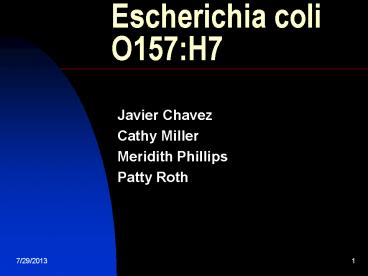Escherichia coli O157:H7 - PowerPoint PPT Presentation
1 / 12
Title:
Escherichia coli O157:H7
Description:
Escherichia coli O157:H7 Javier Chavez Cathy Miller Meridith Phillips Patty Roth Introduction What is E. coli? Vocabulary How is it spread? What are the symptoms? – PowerPoint PPT presentation
Number of Views:544
Avg rating:3.0/5.0
Title: Escherichia coli O157:H7
1
Escherichia coli O157H7
- Javier Chavez
- Cathy Miller
- Meridith Phillips
- Patty Roth
2
Introduction
- What is E. coli?
- Vocabulary
- How is it spread?
- What are the symptoms?
- Who does it affect?
- What is the treatment?
3
What is E. coli?
- Esherichia coli O157H7 is one of hundreds of
strains of the bacterium Eshcherichia coli. - Most strains live in the intestines of healthy
humans and animals, this strain produces a
powerful toxin, veritoxin, which can cause severe
illness and death. - O represents the surface somatic polysaccharide
antigen used for typing - H refers to the flagella atogen
- 157H7 is singled out as the most likely to cause
HUS and death
4
Vocabulary
- Infectious dose- how many bacteria are necessary
to infect and organism - Attack rate- the number of individuals exposed to
and infectious dose who contract the disease - Sequelae- the outcome of the infection
- Transmissible- food born diseases are
transmissible by the fecal-oral route. - Variability- there is variability in the organism
and the host. - Food matrix- the human intestinal system lives in
permanent association with many types of
microorganisms. The diet of the host,
physiological state and genetics of the host
affects the microorganisms
5
Background
- First identified in 1982
- 1992-1993 Jack in the Box food chain outbreak had
500 laboratory-confirmed infections or deaths - 1996 Odwalla juice outbreak illness affected 45
people - 1996, 3000 cases linked to radish sprouts in
school lunch program - 2000, 2300 became ill, 7 deaths from water
contaminated with E. coli from flooding
6
5 Year Trends in Colorado
- www.cdphe.state.co.us/dc/EIP/eco.asp
- Escherichia coli O157H7 is a Shiga toxin
producing bacterium that can cause illness
ranging from mild intestinal illness to severe
kidney complications. Other Shiga toxin
producing serotypes (e.g. O111 and O26) are also
in the family of enterohemorrhagic E. coli and
can cause similar disease.
7
How is it spread?
- The organism can be found in the intestines of
healthy cattle. The meat can be contaminated
during slaughter. - Can be mixed into beef when it its ground into
hamburger. - Bacteria on cows udders or on equipment can get
into raw milk - It can contaminate fruits and vegetables from
contact with manure used as fertilizer - Drinking water contaminated with sewage can carry
the bacteria - The infectious dose is usually under 100
organisms - Can be spread by person to person contact
8
Who does it affect?
- E. coli O157H7 generally affects the young
(including teens) and the elderly
9
What are the symptoms?
- Diarrhea and malaise
- Hemorrhagic colitis(HC) or bloody diarrhea and
abdominal cramps - Lasts for 5-10 days usually
- Infection may proceed to Hemolytic Uremic
Syndrome (HUS), a severe cytopathic attack on the
kidneys requiring intensive care and dialysis.
Red blood cells are destroyed requiring blood
tranfusion
10
Treatment
- Most persons recover without antibiotics or
specific treatment in 5-10 days. - Some antibiotic treatments cause kidney
complications - Antidiarrheal agents should be avoided
11
Prevention
- Cook all beef thoroughly (with no pink in center)
- Avoid eating undercooked meat at restaurants
(send it back) - Keep cooking area clean, wash your hands with hot
soapy water - Keep raw meat away from read-to eat foods
- Drink pasteurized milk and juices
- Wash fruits and vegetables
- Avoid swallowing lake or swimming pools water
12
References
- Center for Disease Control, June 2001
- http//www.cdc.gov/ncidod/dbmd/diseaseinfo/escheri
chiacoli_g.htm (Search under What is Escherichia
coli O157H7)































